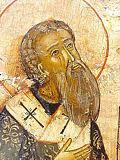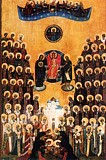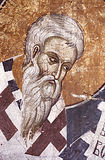

| Previous day | Next day |
| Old Style
June 4
|
Sunday |
New Style
June 17
|
|
3rd Sunday after Pentecost.
Tone 2.
Fast of the Holy Apostles. |
Fish, wine and oil allowed.
|
![]() St. Metrophanes, first archbishop of Constantinople (ca. 326).
St. Metrophanes, first archbishop of Constantinople (ca. 326). ![]() St. Methodius, founder of Peshnosha Monastery (Moscow), disciple of St. Sergius of Radonezh (1392).
St. Methodius, founder of Peshnosha Monastery (Moscow), disciple of St. Sergius of Radonezh (1392).
Martyrs Frontasius, Severinus, Severian, and Silanus, of Gaul (1st c.). Martyr Concordius of Spoleto, Italy (ca. 175). Hieromartyr Astius, bishop of Dyrrachium in Macedonia (2nd c.). St. Zosimas of Cilicia, bishop of Babylon in Egypt (6th c.). New Hieromartyr Ioannicius, metropolitan of Montenegro and the Littoral (1945). Sts. Eleazar and Nazarius, wonderworkers, of Olonets (15th c.).
Sts. Mary and Martha, sisters of St. Lazarus (1st c.). St. Titus, bishop of Byzantium (3rd c.). Hieromartyr Apotacius and Martyrs Zoticus, Atallus, Camasius, Philip, and 31 others, including Eutychius, Quirinus, Julia, Saturninus, Ninita, Fortunio, Gaddanus, and Amasus, beheaded at Noviodunum (Niculitel) (320). St. Optatus, bishop of Milevum in Numidia (376). St. Alonius of Scetis in Egypt (5th c.). St. Petroc, abbot, in Cornwall (594). Monk-martyr John, abbot, of Monagria Monastery, near Cyzicus (761). St. Sophia of Thrace (10th c.-11th c.).
Repose of Hieromonk Bartholomew of Neamts and Svir (1864) and the sisters Vera (June 4) and Lyubov (June 8) of the Shamordino Convent (1883).
Thoughts for Each Day of the Year
According to the Daily Church Readings from the Word of God
By St. Theophan the Recluse

Third Sunday After Pentacost. [Rom. 5:1-10; Matt. 6:22-33]
If therefore thine eye be single[1] thy whole body shall be full of light. But if thine eye be evil, thy whole body shall be full of darkness. Here the mind is called the eye, and the entire composition of the soul is called the body. Thus, when the mind is simple then it is light in the soul; when the mind is evil, then it is dark in the soul. What are a simple mind and an evil mind? A simple mind is one which accepts the word of God as is written, and is convinced beyond a doubt that all is indeed as is written. It has no deceit, no wavering, or hesitation. An evil mind is one which approaches the word of God with slyness, artful disputing, and questioning. It cannot directly believe, but subjects the word of God to its sophistry. It approaches the word not as a disciple, but as a judge and critic, to test something stated there, and then either scoffs at it, or says in a haughty manner, “Yes, not bad.” Such a mind has no firm tenets, because it clearly does not believe the word of God, and its own rationale is always unstable—today one way, tomorrow another. It has only wavering, confusion, questions without answers; everything is out of place with it, and it walks in the dark, fumbling its way. A simple mind sees everything clearly: every thing in it has a definite character, determined by the word of God. That is why every thing in it has its place, and it knows exactly how to behave with relation to things—it walks along open, visible roads, with complete assurance that they lead to the true goal.
[1] In Church Slavonic, the text translates as, If thine eye be pure.
Articles
 Martyrs Frontasius, Severinus, Severian, and Silanus, of GaulThe Holy Martyrs Frontasius, Severinus, Severianus, and Silanus suffered for Christ under the emperor Claudius (41-54). |
 Martyr Concordius of SpoletoThe Holy Martyr Concordius, son of the presbyter Gordian, was raised in piety and faith in Christ, and therefore Bishop Pius of Rome made him a subdeacon. |
 Sts. Mary and Martha, sisters of St. LazarusThe righteous sisters Martha and Mary were believers in Christ even before He raised their brother Saint Lazarus (October 17) from the dead. |
 Venerable Sophia of AinosOur venerable Mother Sophia was born in the province of Ainos in southeastern Thrace , and was the daughter of pious Christian parents. |









